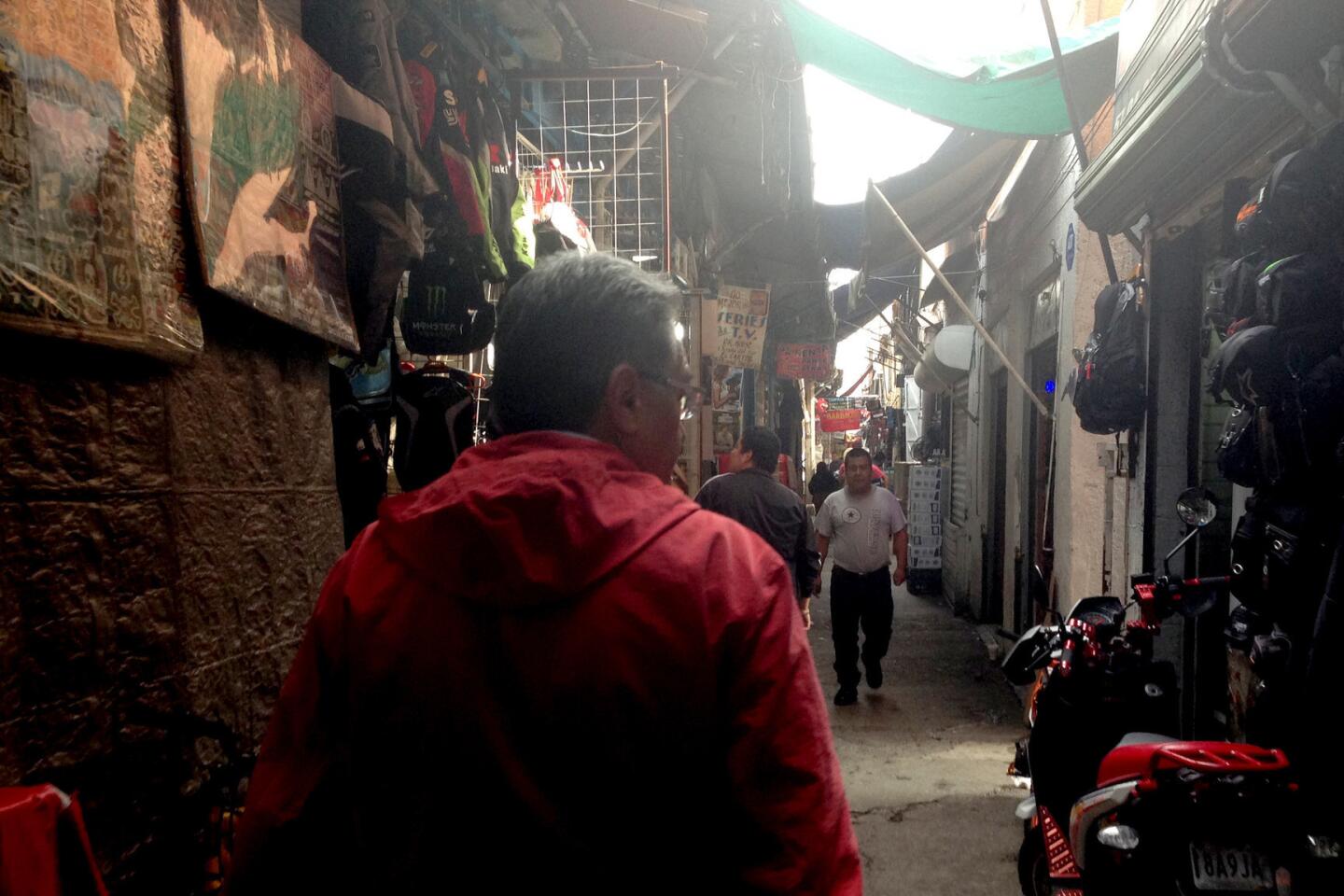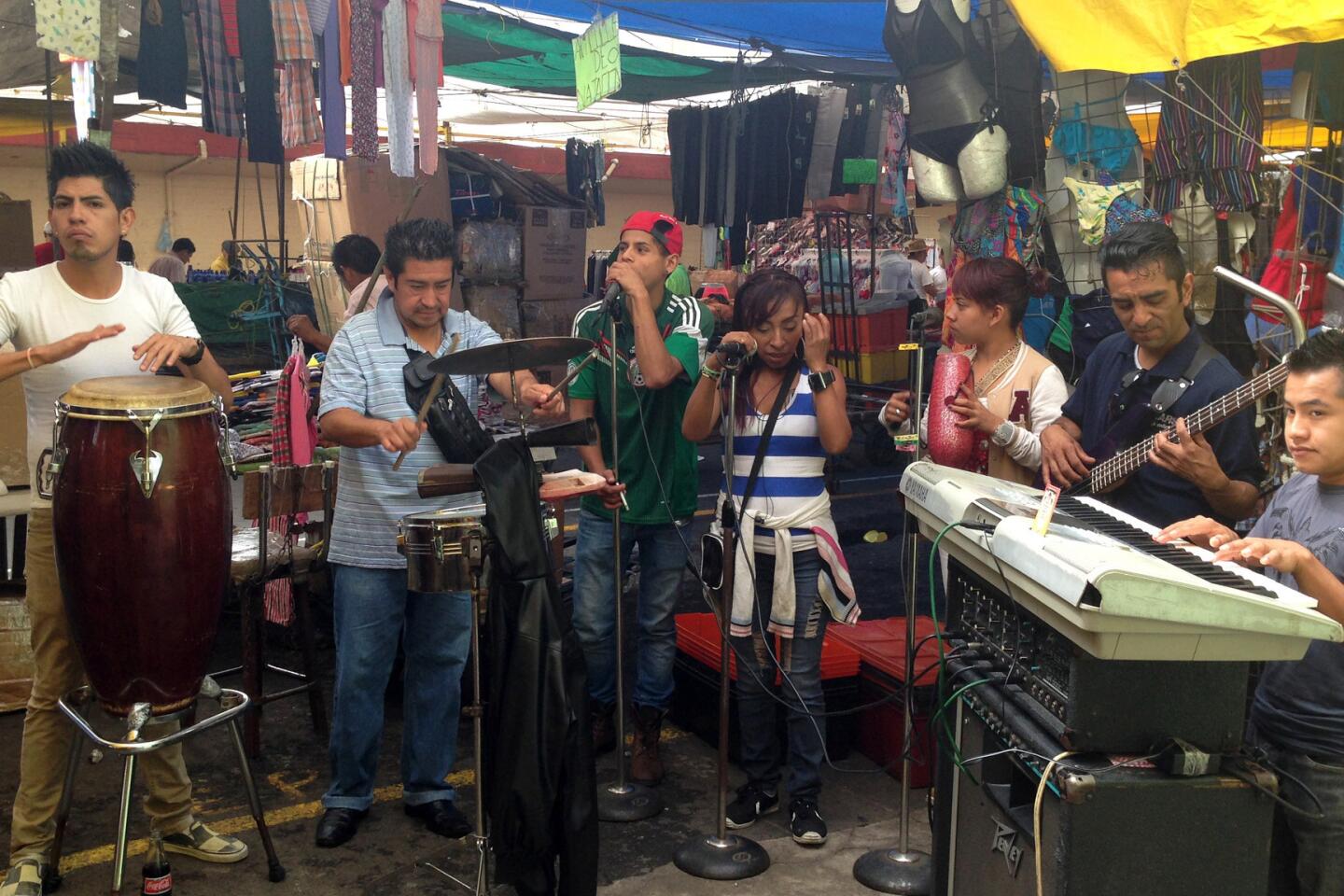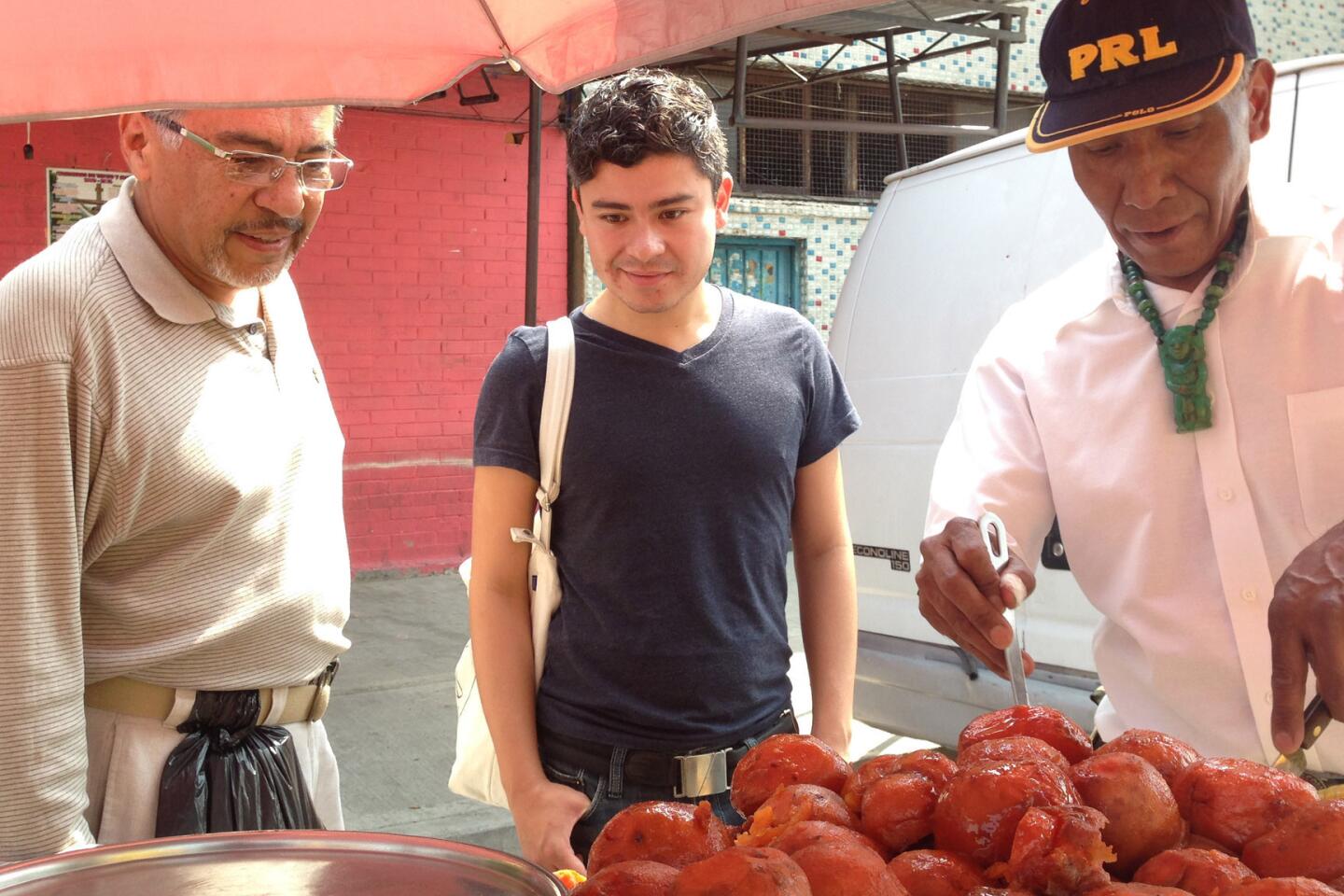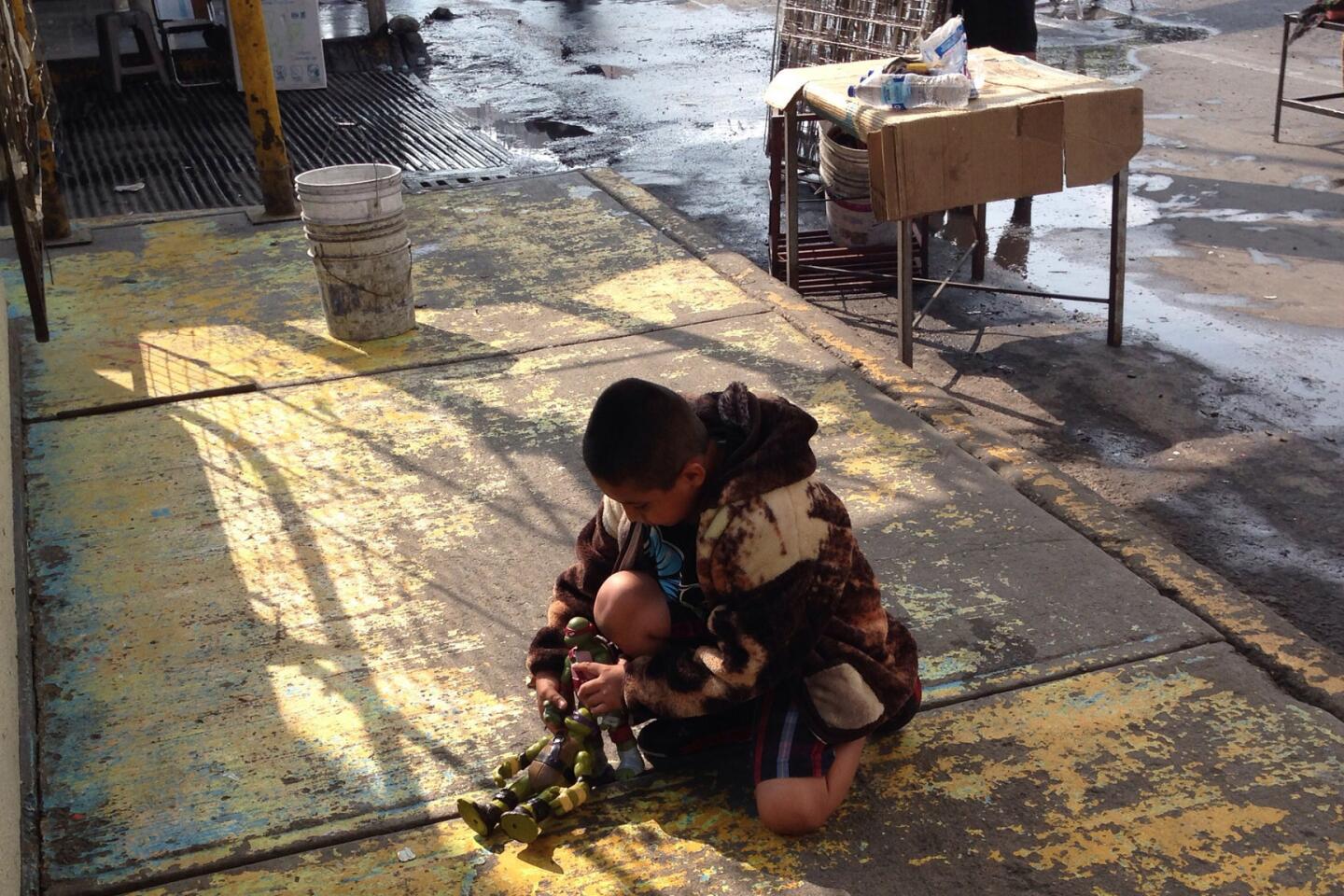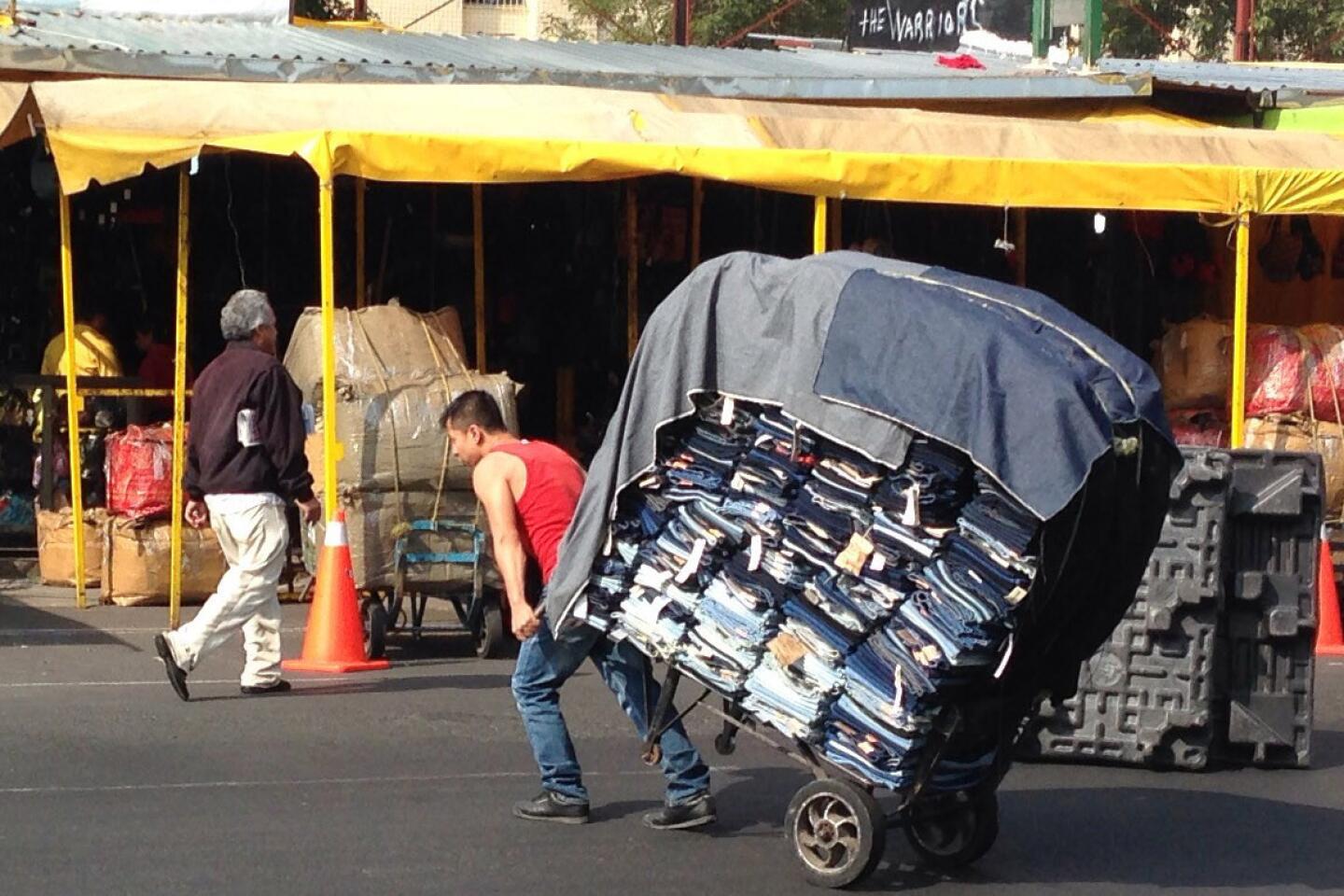Great Read: Mexico City’s ‘Barrio Bravo’ refuses to be conquered
- Share via
Reporting from Mexico City — Alfonso Hernandez stands before a mural of Jesus Christ being ferried on a lion-drawn carriage, trailed by Catholic bishops and priests. Behind them, scores of men in crisp suits — some smiling, some somber, one in dark shades — kneel as they watch the procession.
They are among the dead of Tepito.
“It’s called the mural of the absent. They’re people from here,” said Hernandez, a native of the famously tough — and famously untamable — Mexico City neighborhood. “These are people who died because of the drug wars. This is to remember them here and not just in the crime blotter of the newspapers.”
Hernandez is the chronicler of the “Barrio Bravo” — fierce barrio — where the whiff of danger hangs over even the simple act of walking down the street. (Walk with a purpose, he says. Avoid what locals call the “galleria walk.”)
By day, a vast, bustling marketplace sells items as varied as tripe tacos, freshly squeezed orange juice, Louis Vuitton knockoffs and illegal Chinese cigarettes stacked like Legos. By night, some of Tepito’s streets are a bazaar of a different sort: drugs, guns and vice.
Everything is for sale, locals like to say, but Tepito’s dignity.
Hernandez, 70, whose day job is working for a government office, half-jokingly calls the tours he conducts here “the safari.”
He knows that aside from teaching outsiders about the neighborhood and hopefully humanizing it, he’s also satisfying a need among many visitors to feel like they walked on the wild side and survived Tepito.
Tepito, he says, is a microcosm of Mexico, with its cultural richness, the warmth of its people, their sense of humor, their adroit improvisation in a place where few count on the government for their survival.
And then there’s the rest.
“At the global level, Mexico is corrupt, governed by cartels, with incompetent officials,” Hernandez says. “The same thing that happens at the level of the country happens in Tepito. Why judge Tepito when Mexico is the Tepito of the world?”
::
Few neighborhoods have been the subject of government efforts to try to “rescue” or wrangle it — sometimes resulting in violent clashes — over the years as much as Tepito.
For more than half a year now, the government has been trying again.
“What we’re trying to do is a program of 10 actions to try to reconstruct the social fabric of Tepito, which has been degrading little by little,” says Adolfo Savin, a government official who declared Tepitenos a “very unified people, not easy to defeat” and worthy of respect.
More than a decade ago, then-New York Mayor Rudolph W. Giuliani took a trip to Tepito with a heavily armed entourage with crime-fighting ideas. More recently, food and travel celebrities Anthony Bourdain and Andrew Zimmern visited the neighborhood.
Bourdain said, and not incorrectly: “Tepito is a city within a city. Its own thing. Either the dark center or the beating heart of Mexico City, depending on your point of view.”
Tepito’s outlines existed before the Spaniards; locals say it’s the place where the beloved Aztec emperor Cuauhtemoc was captured. It has the air of a last place to fall.
Resistance, Hernandez said, is in Tepito’s DNA — a point driven home by slogans both spoken and tattooed throughout the barrio.
On one wall, a graffiti-style mural delivers a message that can be translated, with considerable sanitization, as, “We grow like a steak is tenderized, with constant beatings.”
Another: Tepito existe porque resiste. Tepito exists because it resists.
::
Outside the office for the Center for the Study of Tepito, which Hernandez uses as a base, about a dozen young men sit on a bench, waiting for marching orders. They’re paid by merchants to protect them and customers from criminals.
An illustration on a wall behind the men depicts the evolution of “Homo Tepitecus,” concluding with early man becoming a motorcycle rider. Motorcycle and moped riders honk horns and rev engines as they navigate the marketplace’s warren of stalls.
Travel through Mexico City and mention Tepito, and it’s likely someone will give you tips on not being robbed. Hernandez says the everyday danger is exaggerated and mostly confined to a few areas, though it’s definitely best to be vigilant. Don’t wander with a look of overt awe over the sensory bombardment — the scent of organ meats, the ever-present throb of music or that zombie-like young man huffing solvent near the subway. It’ll mark you as an outsider.
In the spring, fliers supposedly from the Gulf cartel were distributed at night through the neighborhood, advertising for recruits. A little more than a year ago, 12 young people from Tepito were kidnapped from a bar in another neighborhood and later found dead. Days later, two masked gunmen entered a gym in Tepito and killed four men.
On Sunday, a shooting left one person dead and two injured, Mexican media reported.
Hernandez tries to expose visitors to Tepito’s bountiful reserve of charisma. He stops by tables serving migas, a soup thickened by stale bolillo bread and heaped with pork shanks laden with marrow.
“The best thing about Tepito is its people and their sentiments. They can give you their heart just as easily as they can give you a beating,” says Monica Frausto, 47, the daughter of the restaurant’s owner. Here the law of reciprocity rules in Technicolor.
Hernandez stops by a stall where Lourdes Ruiz Baltazar sells clothing, a cigarette dangling from her lips and a brown checkered apron wrapped around her slender figure.
Baltazar is known as the champion of albures, a way of speaking using double entendres that she describes as a “puzzle of the mind.” Many of the merchants here have become known as “the Marco Polos of Tepito” because they go to China so often to buy their merchandise. Baltazar just likes to travel; she’s gone to the Vatican, New York, London and Paris. And she’s put up her fists in a couple of those places when someone tried to rob her, she says.
“Here nothing has ever happened to me,” she says. “In Tepito, we don’t think one thing and say another. We speak face to face. We’re not thinking about using words to not hurt feelings. What we have in this barrio is that we’re not hypocrites.”
Leaving the marketplace, Hernandez walks to an altar of the Santa Muerte, or Holy Death. Devotees leave beer, chicken legs, quesadillas and other offerings. Some ask for protection, others retribution.
A man with the Aztec calendar tattooed on top of his shaved head like a skullcap leans against the window and bows his head.
::
Hernandez is standing near the mural of the absent waiting for Martin Camarillo to come out to talk. At that moment, Jesus Ramirez Silva walks by pushing a cart laden with caramelized fruit and yams.
Hernandez buys a snack and admires a large jade pendant depicting a Maya god dangling proudly from Silva’s neck. As the affable vendor pushes his cart down the street, Hernandez is asked whether having such apparently valuable jewelry wouldn’t endanger the friendly merchant.
“He knows karate,” he replies. “And besides, he has an impressive collection of knives.”
Camarillo, 35, rolls out of his house in a wheelchair. Sixteen years ago, he was shot in the back outside a party. Now he spends many of his daylight hours playing Poliana, which involves moving colored pieces around. It’s a game of strategic domination that’s popular in prison, where Camarillo spent some time.
He points to a cross near the mural bearing the nicknames of more than two dozen people who were killed. Many hung out on this street, Camarillo says, adding that by the skin of his teeth he avoided being the first name on it.
He says that most people in Tepito are “very peaceful and hard-working” and that there’s a double standard in how the neighborhood is viewed.
“In high society there’s people that work to steal, who studied to steal,” he says. “Here they steal to study.”
Hernandez knows the neighborhood will continue to get more than its share of scrutiny. It’ll be famous and infamous. What it won’t be is unnoticed. The brand Tepito sells best is Tepito.
“In this city,” he says, “a barrio that doesn’t cast a shadow does not inspire respect.”
Twitter: @hbecerraLATimes
More to Read
Sign up for Essential California
The most important California stories and recommendations in your inbox every morning.
You may occasionally receive promotional content from the Los Angeles Times.
